- Trend 1: The Shift Towards Value-Driven and Content-Led SaaS Marketing
- Trend 2: The Importance of Personalized Onboarding and Customer Success Marketing
- Trend 3: Leveraging Account-Based Marketing (ABM) for B2B SaaS Growth
- Trend 4: The Strategic Use of Freemium Models and Product-Led Growth (PLG) in SaaS Marketing
- Trend 5: The Power of Community Building and Advocacy in SaaS Marketing
- Trend 6: Data-Driven SaaS Marketing and the Importance of Analytics
- Trend 7: Vertical SaaS
- Trend 8: Lower “Software Footprint”
- Key Takeaways
- Frequently Asked Questions (FAQs)
The average business uses more than 100 distinct types of SaaS (software as a service, or subscription-based software), according to a 2025 survey by Okta, the cloud-based authentication software company. If you’re part of a small or medium-sized business, you’re probably using fewer — maybe 30 to 50 — but even that can feel unmanageable. With so many tools in play, chances are some of them are outdated, underutilized, or simply don’t play well with each other, or with the people expected to use them.
SaaS was supposed to make things easier, and for the most part, it has: It wasn’t that long ago that an update to the latest version of a word-processing program or contact database would require your employer’s exasperated IT department to sit with every employee one at a time and hand-install the new version on each individual computer. In the event your company installed software that later proved buggy, you’d have to wait for the error-free version to be sent by the database company. Only with the advent of the cloud in the aughts did this change.
In theory, cloud-based tools are automatically updated and seamlessly maintained at the vendor level, requiring little to no action from users. But, in practice, not all SaaS platforms are created equal: Poor user experience, compatibility issues, and fragmented workflows are still common, which is why it’s crucial to stay informed about the latest SaaS trends — not just to keep up, but to ensure your tools are actually working for you, not against you. This is especially true when it comes to marketing these tools to both new and existing customers. With that in mind, here are some of the top SaaS trends in 2025.
Trend 1: The Shift Towards Value-Driven and Content-Led SaaS Marketing
Unlike traditional pre-cloud software (think of old-school Adobe Photoshop, for example, or even a console-based video game), SaaS isn’t a one-off purchase — it’s an ongoing commitment with a monthly price tag. More than ever, SaaS buyers expect clear, tangible value before signing up — even free trials are no longer enough of a novelty to make a company stand out.
The most recent marketing studies show that what’s old is new again. Good old-fashioned content leads the way, with video and visual content and thought leadership at the top, according to the 2024 LinkedIn B2B Benchmark report.
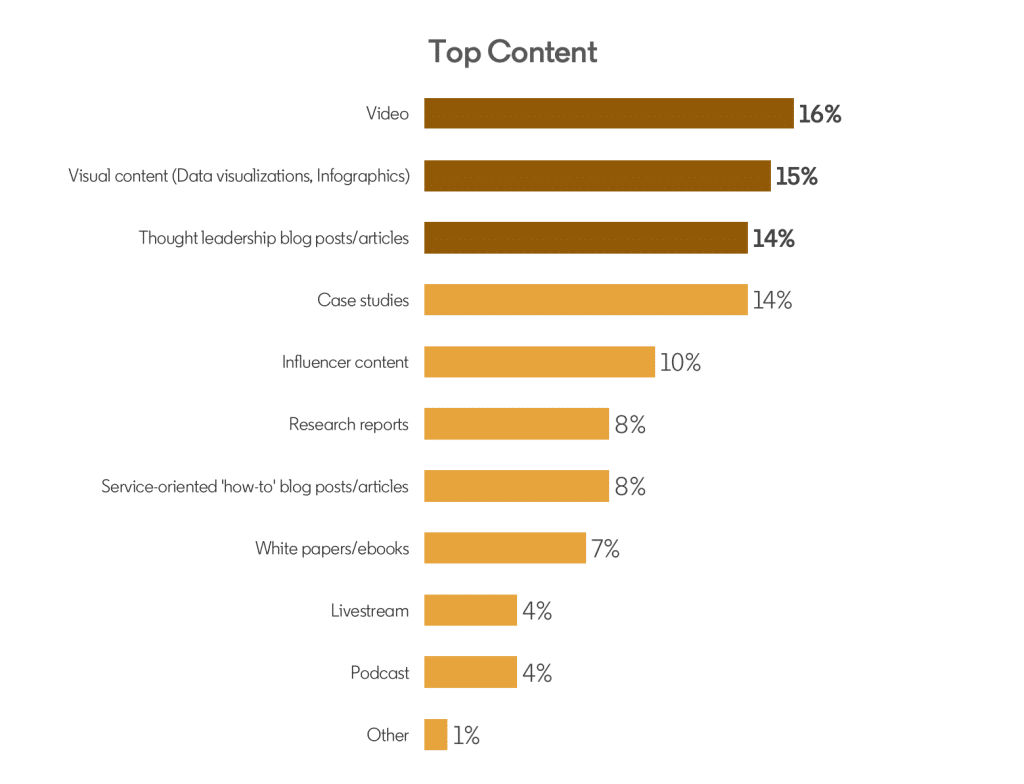
(Source: 2024 LinkedIn B2B Marketing Benchmark Report)
That’s why 2025 is witnessing a surge in value-first content marketing strategies.
Educational Content
Long-form, authoritative content like how-to guides and comparison articles are proving especially effective in capturing intent-rich traffic. Brands that rank highly for educational search terms (“Why does intermittent fasting work,” “Is crypto a good investment?” etc.) are getting more qualified leads than those relying solely on product pages.
To amplify visibility, savvy advertisers are repurposing content across channels, turning blog posts into LinkedIn carousels, webinars into YouTube or TikTok clips, and product demos into sponsored content. The latest AI-driven marketing tools can help optimize distribution by targeting based on first-party engagement data and recommending the best time, format, and channel for content amplification.
Thought Leadership
Thought leadership is not just a gimmick to inflate the egos of a company’s C-suite — it’s a way to earn the trust of customers and stand out in a competitive market. Performance marketers can support this by developing campaigns that not only generate leads, but also elevate expert voices via earned and sponsored media.
According to the Edelman 2024 B2B Thought Leadership Impact Report, 52% of polled B2B decision-makers and 54% of C-level executives spend an hour or more on average per week reading thought-leadership content. Moreover, 73% of decision-makers valued a company’s thought leadership content over its marketing materials.
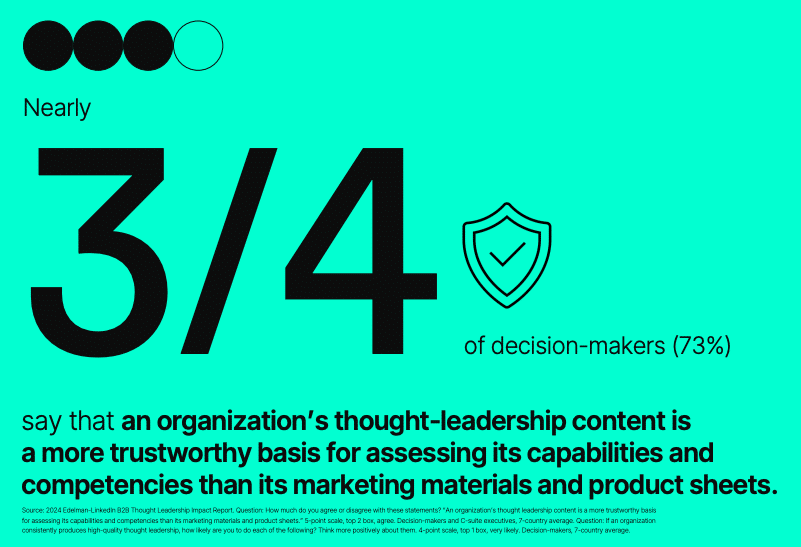
(source: Edelman, 2024 B2B Thought Leadership Impact Report)
Better still, thought leadership is one of the most cost-effective ways to gain new customers. According to FirstPageSage, thought leadership has one of the lowest CACs (customer acquisition costs) of any channel, at $642 for B2B CAC and $298 for CTC CAC, as compared to an overall average of $942 and $480, respectively.
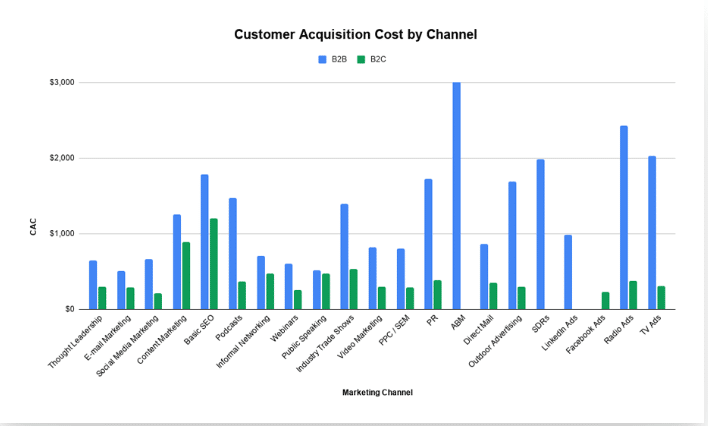
(Source: FirstPageSage)
Trend 2: The Importance of Personalized Onboarding and Customer Success Marketing
You no doubt know that it’s much more expensive to get a new customer than to retain an existing customer. This is especially the case with any subscription involving recurring fees, e.g. SaaS. At a time when customer acquisition costs are rising and churn can eat into profit, retention is the name of the game. Thus, the post-sale experience is becoming a core focus of SaaS marketing.
The Role of Personalization in Onboarding
The first 30 days after signup can make or break the customer relationship. A McKinsey & Co. study on personalization showed the extent to which customers expect the businesses they buy from to recognize them as individuals and know their interests.
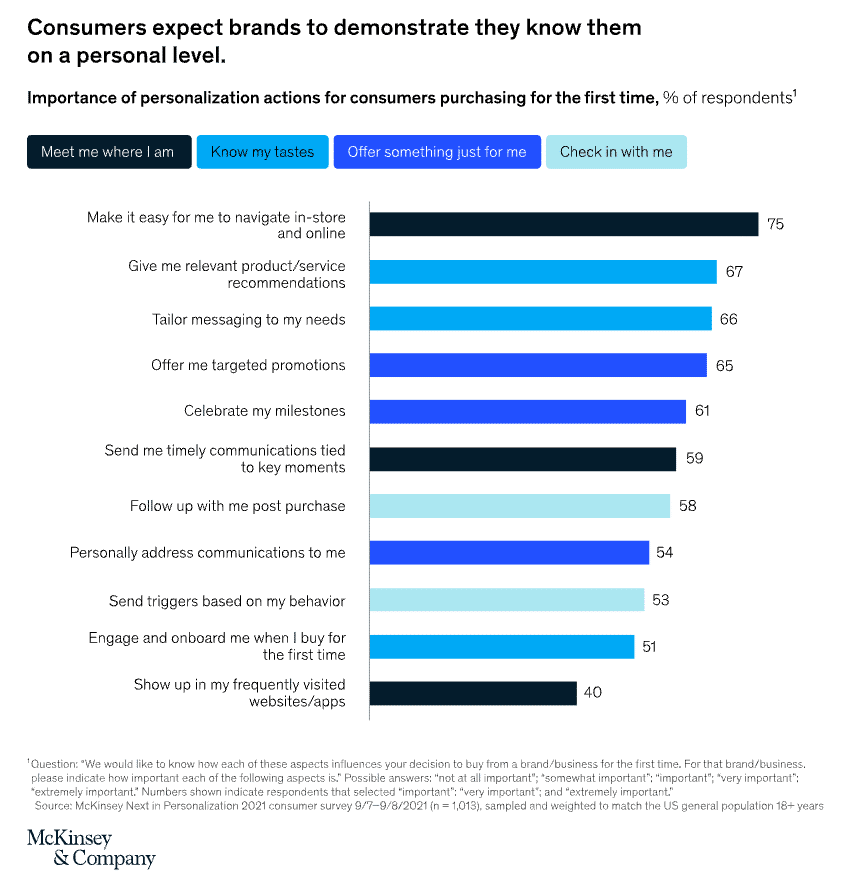
(Source: McKinsey & Co.)
That’s why SaaS companies are embracing AI-powered onboarding flows that adapt based on user behavior, industry, and plan type. Advertisers can play a crucial role here by helping clients segment new users and retarget them with personalized messages: Onboarding tutorials, feature explainers, or case studies that mirror the user’s needs, e.g. Platforms that leverage cohort-based first-party data can offer more granular personalization based on past behavior and expected user outcomes.
Customer Success as Marketing
Customer success teams are no longer reactive support desks — they’re now proactive marketers. Smart SaaS brands are building automated journeys that target existing users with upsell offers, satisfaction surveys, and referral programs. Advertisers can amplify these efforts with targeted re-engagement campaigns to dormant users and post-conversion nurture sequences.
Trend 3: Leveraging Account-Based Marketing (ABM) for B2B SaaS Growth
ABM, which involves targeting high-value accounts rather than casting the widest possible net, is no longer just a “nice to have” in B2B SaaS — especially for products with longer sales cycles or enterprise-level pricing.
ABM Strategy Must-Haves
An effective ABM strategy involves:
- Identifying high-value target accounts.
- Mapping stakeholders within those accounts.
- Delivering personalized content across multiple channels.
Platforms that offer real-time performance optimization based on first-party behavioral data are critical here. The latest AI-driven marketing software is indispensable in this area, helping advertisers track multiple decision-makers across the funnel and surface dynamic messaging based on firmographic signals, giving ABM campaigns the agility they need to work.
Sales-Marketing Alignment
One trend in ABM that’s flying under the radar? The growing teamwork between marketing and sales. By sharing real-time data on how leads are behaving and ranking potential clients, marketers are helping both teams work smarter — knowing exactly when to turn up the heat or take a step back.
Trend 4: The Strategic Use of Freemium Models and Product-Led Growth (PLG) in SaaS Marketing
According to the non-profit PLG Collective, “Sales-led and marketing-led had their time. The future is product-led growth.”
Product-led growth (PLG) is a strategy where the product drives business growth. Rather than depending on sales teams or marketing efforts to attract customers, PLG companies offer direct product access through free trials or freemium models. When users experience the product’s value, they convert to paying customers and often recommend it to others.
PLG Is the New Funnel
In PLG, the product markets itself. It’s not a funnel; it’s often described as a flywheel. Users sign up for free, get value fast, and expand organically.
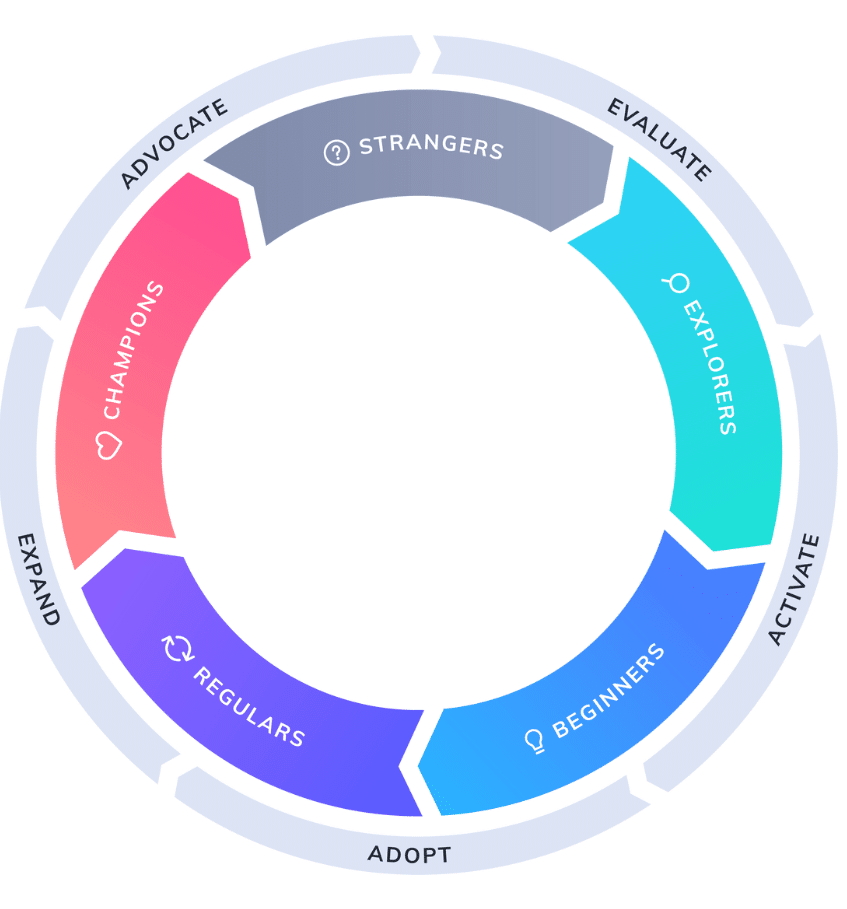
(Source: PLG Collective)
Key Differences Between a Traditional Marketing Funnel and a PLG Flywheel
| Traditional Funnel | PLG Flywheel |
| Customer is the end | Customer is the center |
| Sales/marketing-led | Product-led |
| Linear journey | Circular, self-sustaining |
| Push to buy | Try, like, then buy |
| Focus: acquisition | Focus: adoption, retention |
In short:
Funnel = convince first, then show product.
PLG = show product first, let it convince.
But, PLG doesn’t mean marketers are obsolete — it means they need to shift from pushing features to optimizing experiences. Advertisers can support PLG with campaigns that target free users just as they’re reaching value inflection points when they’re most likely to upgrade.
Metrics That Matter
For freemium and PLG brands, the key KPIs have shifted from “leads” to:
- Product Qualified Leads (PQLs): Potential customers who show strong interest in a product by actively using it or engaging with key features during a trial or free version.
- Time to Value (TTV): How quickly a customer can start seeing benefits or results after using a product or service.
- Feature Adoption Rate: The percentage of users who start using a specific feature of a product over a certain period.
- Expansion Revenue: Extra income generated when existing customers upgrade, buy add-ons, or increase their usage of a product or service.
Ad platforms that can capture these deeper metrics — not just clicks — will lead the next wave of SaaS advertising.
Trend 5: The Power of Community Building and Advocacy in SaaS Marketing
Building Digital Communities
Brands are leaning into customer-led growth more than ever. Whether it’s Slack groups, Discord servers, or niche LinkedIn collectives, SaaS companies are building micro-communities where customers can share tips, solve problems, and celebrate wins. These communities aren’t just for support — they’re for retention and referral. Digital advertisers can help by directing like-minded users into these communities and even promoting top user-generated content (UGC) as ads.
Activating Advocates
Happy customers are your best sales reps. Advertisers can work with SaaS brands to identify power users and build campaigns around their stories. Incentivized review requests, customer video testimonials, and expert Q&As can be turned into high-performing native or programmatic campaigns. Again, marketing tools that tap into long-term behavioral data can identify who’s truly loyal and most likely to influence others.
Trend 6: Data-Driven SaaS Marketing and the Importance of Analytics
Metrics SaaS Marketers Live By
Marketing without analytics is like flying blind, and in SaaS, that’s a risk no one can afford. The best SaaS advertisers track a blend of performance and customer metrics:
- Customer acquisition cost (CAC).
- Lifetime value (LTV).
- Monthly recurring revenue (MRR).
- Churn rate.
- Activation rate.
- Funnel conversion rates (from trial to paid, etc.).
Why AI Makes a Difference
AI doesn’t just crunch numbers — it finds insights marketers didn’t know to look for. Using predictive analytics, AI can flag accounts at risk of churning, recommend retargeting schedules, and even propose new audience segments based on lookalike behavior. It’s a powerful helper, like it or not, and you don’t want to fall behind in mastering the latest AI-based marketing tools: According to the Linkedin 2024 B2B Marketing Benchmark report, AI is the fourth-fastest growing overall skill and the fastest-growing digital skill for B2B marketers.
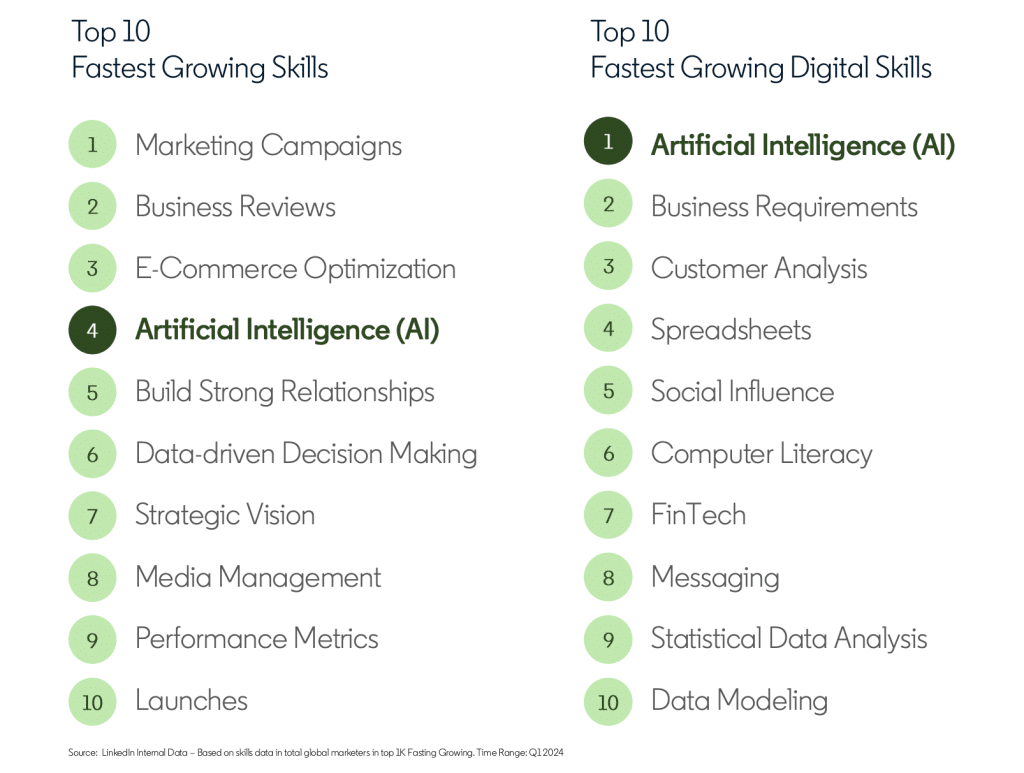
(source: LinkedIn 2024 B2B Marketing Benchmark report)
Trend 7: Vertical SaaS
For years, the SaaS world was dominated by horizontal platforms — industry-agnostic tools like Salesforce, Slack, or Quickbooks that are designed to be used by any type of company. We couldn’t get by without them. But, in 2025, one of the most significant shifts is the rise of vertical SaaS: Software designed specifically for the needs of a particular niche.
Unlike one-size-fits-all solutions, vertical SaaS platforms are tailored to the workflows, regulations, data structures, and customer expectations of a specific need — be that performance marketing, personnel management, or workplace benefits administration. That specialization means less customization is required out of the box, and users typically see faster onboarding, better adoption, and more actionable insights.
Why the shift? Industries are realizing that generic tools, while flexible, often require heavy customization or workarounds to meet real-world needs. Vertical SaaS addresses those pain points directly. For example, instead of using one tool to keep track of a variety of functions, vertical platforms answer those specific needs more effectively. The result: A better fit with less effort.
The latest AI-based marketing tools, for example, deliver industry-specific insights, KPIs, and recommendations that directly reflect the metrics that matter most in performance marketing, like click-through rates, conversion trends, creative fatigue, and audience performance.
Trend 8: Lower “Software Footprint”
There’s a raging “low code/no code” movement in the SaaS world. Although code isn’t a physical object taking up space, some software engineers believe that too much code increases the likelihood of errors and makes updates difficult. So-called LCNCers think that software should be created with as little coding as possible.
Even if you’re LCNC-agnostic, the movement has had its effects on the software market. There’s now a greater demand than ever for platforms that empower non-technical users to create workflows, automate tasks, and even build full applications without writing a single line of code. For growing businesses that can’t afford large development teams, this is a huge win, as it drastically reduces reliance on IT and accelerates time-to-value for internal tools and customer-facing products.
Key Takeaways
SaaS marketing in 2025 is increasingly value-led, product-driven, and performance-obsessed. Digital advertisers must go beyond lead gen and support SaaS clients across onboarding, retention, and advocacy. Freemium models, ABM, and thought leadership aren’t trends: They’re now essentials. Data remains king, but only when used proactively to drive insight and action.
Frequently Asked Questions (FAQs)
What are the most effective digital advertising channels for SaaS in 2025?
Native advertising, search, and email continue to dominate as the most effective digital advertising channels for SaaS. But, platforms offering contextual targeting and proprietary first-party data are rising in popularity due to cookie deprecation and performance reliability.
How can SaaS companies reduce churn through digital marketing?
SaaS companies can reduce churn by using personalized re-engagement campaigns, in-product messaging, and retargeting based on churn signals. AI-powered tools can detect at-risk users early and help reduce churn through tailored experiences.
What are some successful examples of SaaS digital marketing campaigns?
Brands like Slack and Notion have excelled with PLG (product-led growth) combined with content-led strategies. Thought leadership paired with smart distribution — especially via native ad platforms — has been a key driver of success.
How is AI impacting the SaaS marketing landscape?
AI is enabling hyper-personalization, smarter budget allocation, and predictive targeting. AI-driven SaaS continuously learns from engagement data, allowing users to adapt campaigns in real time.
What are the key metrics for measuring success in SaaS digital marketing?
Beyond CTR and impressions, SaaS marketers track CAC, activation rate, and churn, among others. Success is now defined by revenue and retention, not just clicks.



